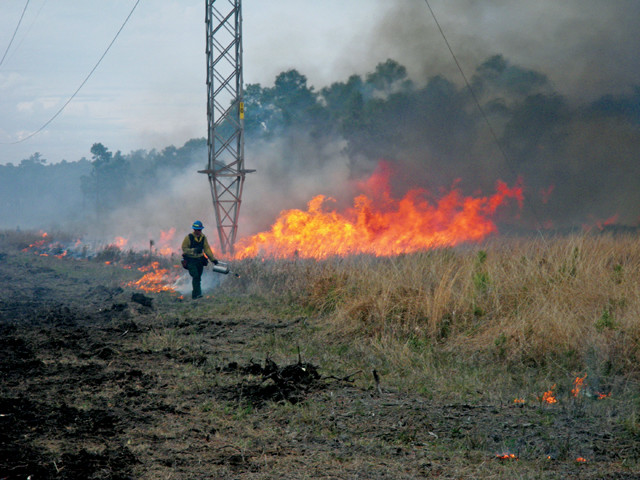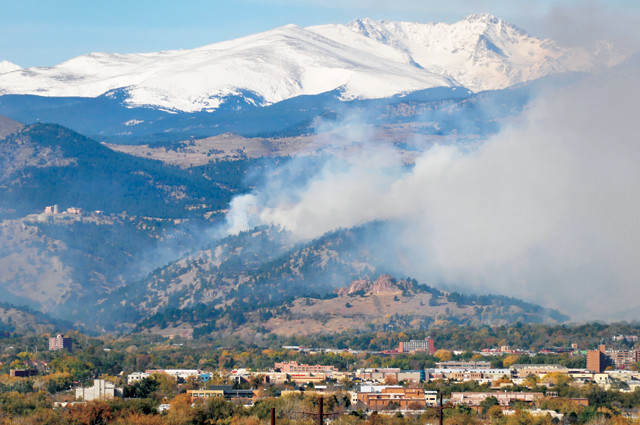
by Bethany Augliere Thursday, January 26, 2017

Researchers found that grass and crop fires produce more nitrogen pollutants than wildfires. Credit: USFWS, CC BY 2.0.
Smoke from fires — whether from wildfires or from residential and agricultural grass and crop burning — carries pollutants into the air that affect climate and can be toxic to humans and ecosystems. According to new research, smoke from crop and grass fires appears to contain higher levels of some hazardous nitrogen-containing chemicals than wood fire smoke. The work also calls into question whether certain chemicals commonly used as distinctive signatures of biomass burning are still valid.

Researchers studying how much smoke affects residential air quality in places like Boulder, Colo., shown here with smoke from the 2010 Dome fire). Anders Knudsen, CC BY-SA 2.0
Burning vegetation results in emissions of nitrogen-containing volatile organic compounds, called NVOCs, among other chemicals, into Earth’s atmosphere. Two types of NVOCs, hydrogen cyanide and isocyanic acid, can cause inflammatory responses in human lungs. Nitrogen oxides, which react in the air to produce pollutants like ozone that are harmful to air quality, are also released when plants are burned.
“How much does residential burning affect air quality in cities like Boulder and Aspen?” asks Matthew Coggon, an atmospheric scientist at Cooperative Institute for Research in Environmental Sciences at the University of Colorado Boulder and lead author of the new study, published in Geophysical Research Letters. “We were interested in probing this question because biomass burning, and specifically residential burning, has very uncertain impacts on regional air quality, climate change and health.”
Coggon’s team set out to determine how the chemical compositions and NVOC levels in smoke relate to their source material, using both mobile and ground platforms to collect air samples in Aspen and Boulder.
By driving around in a lab on wheels, the researchers could locate smoke plumes and quickly evaluate the source of the smoke using a high-resolution mass spectrometer that is capable of measuring thousands of compounds every second. “Getting as close to the source [of smoke] as possible allows us to profile the ‘fresh’ emissions,” Coggon says.
The results confirmed findings from laboratory studies showing that smoke from wood fires generally carries less nitrogen than smoke from crop and grass fires. This study is the first to confirm that observation in the field and to show the link between higher nitrogen fuel content and higher concentrations of NVOCs in smoke, Coggon says.
Perhaps more interesting, Coggon says, is that the team did not detect acetonitrile at high levels in smoke from wood fires. Acetonitrile is an NVOC that’s commonly used as a marker of biomass burning because it is not released through the combustion of other materials such as fossil fuels. Concentrations of acetonitrile were roughly 10 times higher in crop fires than wood fires.
“That’s a big deal,” says Greg Huey, an atmospheric scientist at Georgia Tech who was not involved in the study. Acetonitrile is a long-lived pollutant in the air, with an average residence time of 1.5 years. Scientists currently use it to determine the contribution of wood burning to air pollution in places like Denver, where wood burning is common, Huey says. This study overturns assumptions about its use as a marker of biomass burning, he says.
The variation in NVOC levels among different kinds of fire may arise in part because the nitrogen compounds released can vary even within a single plant, Coggon says. So, if you were to burn different parts of a tree that contained the same amount of total nitrogen, you might see different amounts of acetonitrile, hydrogen cyanide or isocyanic acid in the smoke. This is potentially due to different proportions of amino acids occurring within different parts of plants, he says, suggesting the molecular-level details of a fuel source can lead to drastically different emissions. There’s “a long way to go before we truly understand how fuel composition and emissions are linked,” he says.
Coggon says his team plans to expand the work, mounting their instruments on airplanes and flying over wildfires to better understand the compositions of wildfire smoke. Finding new markers of biomass burning is also important, Huey says. For instance, he notes, the new study shows that the organic compound furfural might be suitable as a tracer to identify wood-stove burning in urban areas. Furfural is present in wood smoke, but not other emissions, like those from cars, gas or oil.
One thing that is clear, Huey says, is that the impact of biomass burning on the atmosphere has been largely underestimated, perhaps due to a lack of good chemical markers. Wildfires in the U.S. are getting more prevalent and agricultural burning is increasing, Huey says. “This is probably one of the bigger challenges in air quality that we are facing in the next decade — we have to do a better job.”
© 2008-2021. All rights reserved. Any copying, redistribution or retransmission of any of the contents of this service without the expressed written permission of the American Geosciences Institute is expressly prohibited. Click here for all copyright requests.